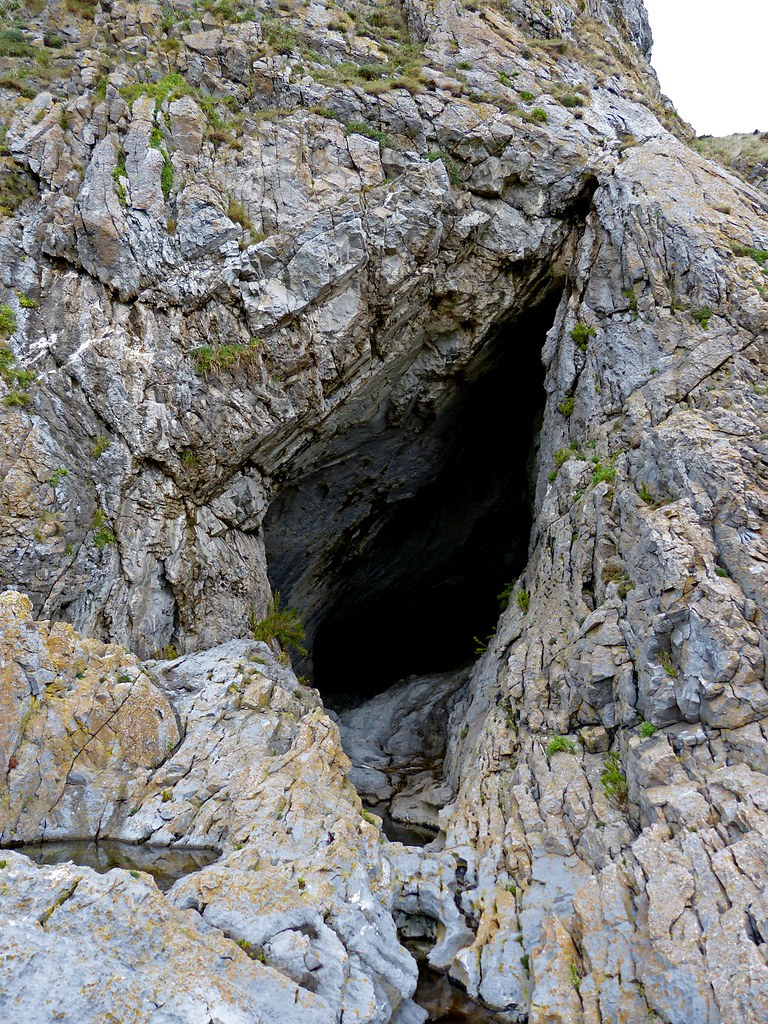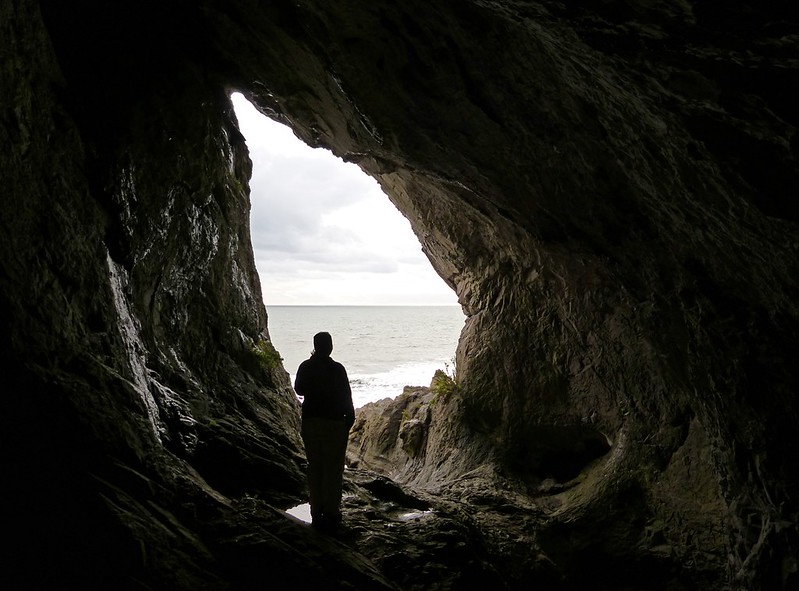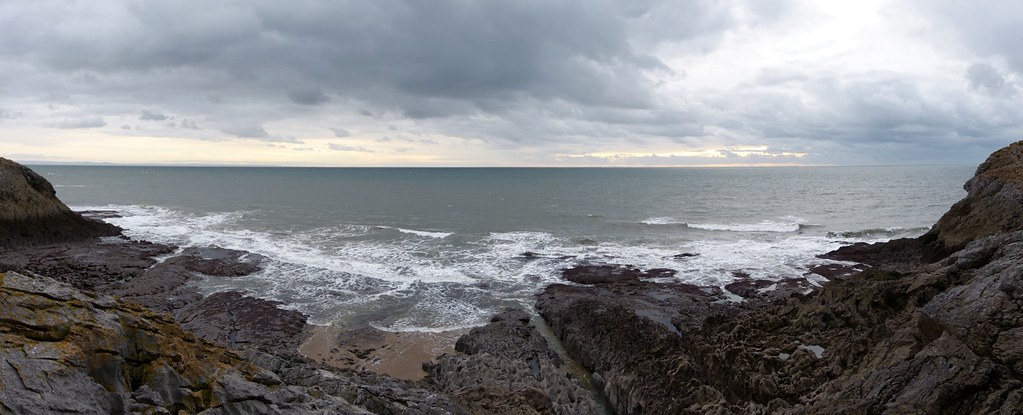Paviland Cave on Gower has long featured at the top of my list of places to visit with past attempts being thwarted by high tides and a degree of doubt over the caves exact location. Armed with GPS coordinates and a favourable tide on Sunday however, it finally looked like we were ready to make a successful infiltration. We set off from Port Eynon just after midday and walked the couple of miles to where a steep sided valley cuts a narrow track down to sea level and the cave entrance. The latter is completely obscured from view unless you are out on the water, but putting our trust in technology we were confident it was there. Low tide was still about an hour away at this point but it was dropping at such a rate that more rocks were appearing with each passing minute. We still had a half hour or so to wait though, time which was spent in slightly surreal surroundings. With almost vertical cliffs of rock on each side and just a narrow view out onto the sea we felt completely isolated and it wasn’t hard to imagine what the place must have been like when our ancient ancestors lived and hunted there. That sense of times gone and life spent was only heightened by a leaden sky and one Raven whose croaking calls were amplified greatly in our confined surroundings. All we needed was a Vulture perched on one of the cliffs to complete the sense of foreboding, but I guess a Peregrine Falcon passing within a couple of meters will have to suffice. I’d be lying if I didn’t say that it came as a relief to finally cross over the newly exposed landscape and clamber up the twenty or so meters to the cave entrance (you can approach from above but that requires climbing gear and ropes).

The pear shaped opening that greets those intrepid enough to make the journey measures about seven meters tall by four meters wide, an impressive entrance to what is undoubtedly one of the worlds most famous caves. It first burst onto the international scene back in 1822 when two locals from Port Eynon, Daniel Davies and Rev John Davies, carried out its first exploration and discovered animal bones which included a Mammoth tusk. Following more ‘elephant bone’ finds in December that year, a week long dig was organised for the following month. This was to be led by the Professor of Geology at Oxford university, William Buckland. It was during those excavations that he made the startling discovery of a human skeleton, better known today as the Red Lady of Paviland.
“I found the skeleton enveloped by a coating of a kind of rubble … which stained the earth, and in some parts extended itself to the distance of about half an inch around the surface of the bones … Close to that part of the thigh bone where the pocket is usually worn surrounded also by rubble were about two handfuls of periwinkle shells. At another part of the skeleton, viz in contact with the ribs were forty or fifty fragments of ivory rods also some small fragments of rings made of the same ivory and found with the rods … Both rods and rings, as well as the shells, were stained superficially with red, and lay in the same red substance that enveloped the bones.”
The hollow where the skeleton lay is still clearly visible in the cave today.

Bucklands creationist upbringing meant he did not believe that any human could exist from before the Biblical great flood, leading him to vastly underestimate the age of his find. He dated it as Roman and believing it to be a women presumed that the red colouration must have indicated she was either a prostitute or witch. It wasn’t until a second dig in 1912 that the similarities with other European skeletons was realised, allowing its age to be pushed much further back into the Palaeolithic era. With the invention of carbon dating in the 1950’s that date was further refined until in 2009 a final age of 33,000 years was stated. This makes the Red Lady the oldest ceremonial burial of a modern human ever found in western Europe.

The Red Lady name is slightly misleading these days as we now know the ‘lady’ to have been a male of about 21 years when he died. He was most likely a tribal chieftan and lived just before the last ice age at a time when sea levels were much lower than today. Back then Paviland Cave would have offered commanding views over a lush plain and was probably chosen as a final resting place for those very reasons.

If you get a chance and the tides are with you I highly recommend a visit, not just because the cave is an impressive sight but also because of what it represents. I find it fascinating that in relatively recent history such a place could have existed and yet its secrets be completely unknown. In a similar vein of exploration I have found reference to another cave system less than a mile away from Paviland and running about 150 meters underground. The entrance to this one will be on hands and knees but somewhere within lies an abandoned mining cart and allegedly an engraving from a first world war soldier. Needless to say my appetite has been suitably whetted and it is on my list of things to do in 2013. Watch this space.



4 Comments
Debs F Grant · November 27, 2012 at 9:10 pm
I have never heard of this cave. What a fascinating read! Thank you.
Gillian Olson · November 28, 2012 at 4:44 pm
Great story, and new to me. Thank you.
Unknown · November 29, 2012 at 10:36 am
The cave at Paviland is a wonderful spot, made more special by its history and the slight difficulties in getting to it. Your post brought back memories of our own visit, probably getting on for 15 years ago. I seem to recall Swansea Museum holds artefacts from the cave and buriel.
Thanks for sharing your adventure and reminding me of our own visit.
scott davidson · March 2, 2013 at 9:35 am
How are we looking at the paintings of Mark Rothko these days?
Is he old hat, replaced in America by more contemporary concerns? Looking at his minimal canvases and their enticing floating squares of subdued paint live at the MOMA recently, I had to stop to wonder whether he still communicates to a modern and younger audience.
Wahooart.com, the site that sells good canvas prints to order from their database of digital images, has many Rothko prints. I ordered this one, Blue and grey, http://EN.WahooArt.com/A55A04/w.nsf/OPRA/BRUE-8BWU7F, that I have now hanging in my study. I can spend a long time looking at this elusive image that takes me to some other place not in this world.